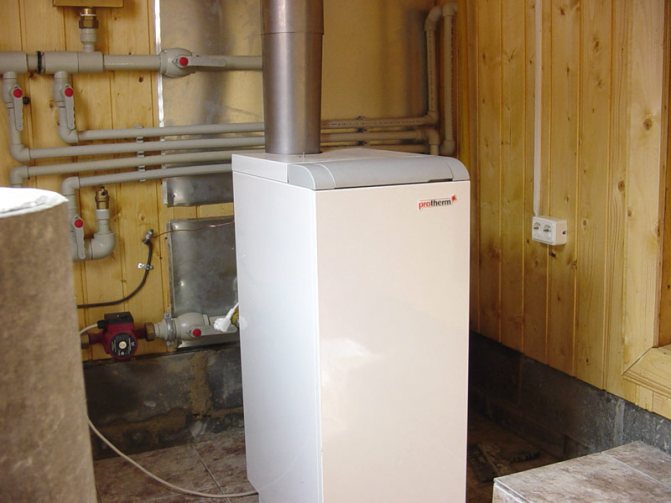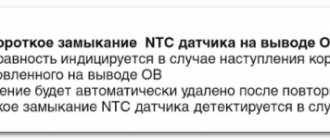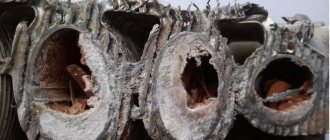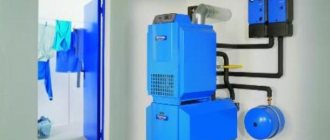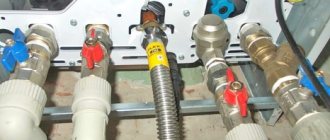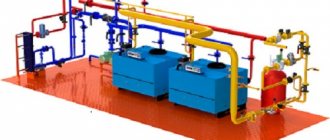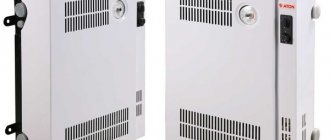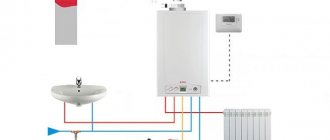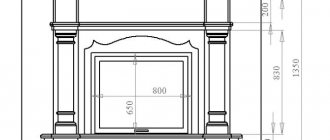Boiler heat exchanger
At the beginning, remember that the heat exchanger is the main element, as such, in the device of a gas boiler. It is through the heat exchanger that the heat energy from the combustion gas is transferred to the heat carrier (primary heat exchanger) and through the heat exchanger is transferred from the hot heat carrier to the cold one (secondary heat exchanger). It is worth noting that both of these heat exchangers are very often replaced by a mixed heat exchanger, which is better known as a bithermal heat exchanger. In the first photo we look at the location of the heat exchanger in a gas boiler with a closed combustion chamber.

The second photo shows the appearance of the heat exchanger.
Manufacturers
Currently, on the Russian market you can find a large number of various models of cast iron gas boilers, which are produced by different manufacturing companies. Let's consider the most popular ones.
Ariston (Italy)
Gas boiler with cast iron heat exchanger Ariston Unobloc
Ariston produces atmospheric gas cast iron boilers of the Unobloc series. They are well suited for domestic operating conditions, are distinguished by their reliability and long service life. The efficiency of the devices is high, reaching up to 90%. The lineup is represented by devices with a power from 24 to 64 kW.
The cast iron heat exchanger is not subject to corrosive processes and various thermal stresses. The complete set of the atmospheric burner includes electric ignition and ionization control of the flame. The set of Ariston boilers, the power of which varies in the range from 24 to 31 kW, includes a circulation pump, an expansion tank, a safety valve and a minimum pressure switch.
Due to the large abundance of units made in various design solutions, everyone can choose a heating device that will not only become a source of heat, but also perfectly fit into the interior.
Biasi - Italian gas boilers with a cast iron heat exchanger.
Baxi (Italy)
Models of floor-standing gas boilers with a cast-iron Slim heat exchanger from Baxi got their name due to their small dimensions (width is only 35 cm). In this regard, they can be placed in any room, even the smallest. The manufacturer offers units with atmospheric and inflatable burners. Power ratings range from 15 to 62 kW.
During the operation of the boiler equipment, continuous electronic modulation of the flame occurs both in heating mode and in hot water supply mode. These Baxi cast iron boilers are distinguished by high safety, they are equipped with an electronic self-diagnosis system, ionization flame control, a protective thermostat against liquid overheating in the primary heat exchanger, as well as a draft sensor to control the removal of combustion products.
If your boiler room is large enough and you need a more powerful boiler, then Baxi offers a range of atmospheric burner units, ranging from 83 to 116 kW. The boilers are very well suited for operation in Russian conditions.
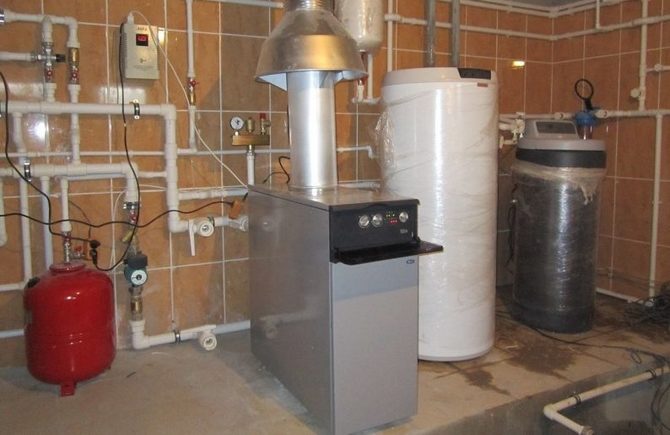

Gas floor boiler Baxi SLIM
Electrolux (Sweden)
Floor standing gas boiler Electrolux FSB 50 Mi
Cast iron heating boilers Electrolux are represented by the FSB series, which includes both single-circuit and double-circuit devices with natural removal of combustion products.
Due to the fact that the production is carried out according to the most modern technologies, the devices have a long service life and are very economical in fuel consumption.
It is worth noting that Russian cast-iron gas boilers are not much inferior to European counterparts in their technical and operational characteristics and are also very popular among users.
Thanks to the sectional cast-iron heat exchanger made using the Drop Stop technology, the Electrolux gas boiler can successfully operate for 25-30 years.
Heat exchangers made of steel
The steel heat exchanger is technologically the easiest to manufacture. Hence the low cost of such boilers, and hence their availability.
Steel, as a material, has good ductility, and therefore, under the influence of temperatures, a heat exchanger made of steel is less susceptible to thermal deformation.
At the same time, steel is susceptible to corrosion, which means that the service life of a boiler with a steel heat exchanger is relatively shorter. And the weight of such boilers is large, but the efficiency is not the best.
Gas boiler heat exchanger material: which is better
It surprises me when people do not think about the material from which the heat exchanger in the boiler is made. After all, this is one of the most important elements of heating equipment. The efficiency, heating rate and, most importantly, service life depend on the material. In addition, they can contain a second outline. So that you understand which heat exchanger is better, I want to talk about the advantages and disadvantages of each of them.
First cast iron heat exchangers
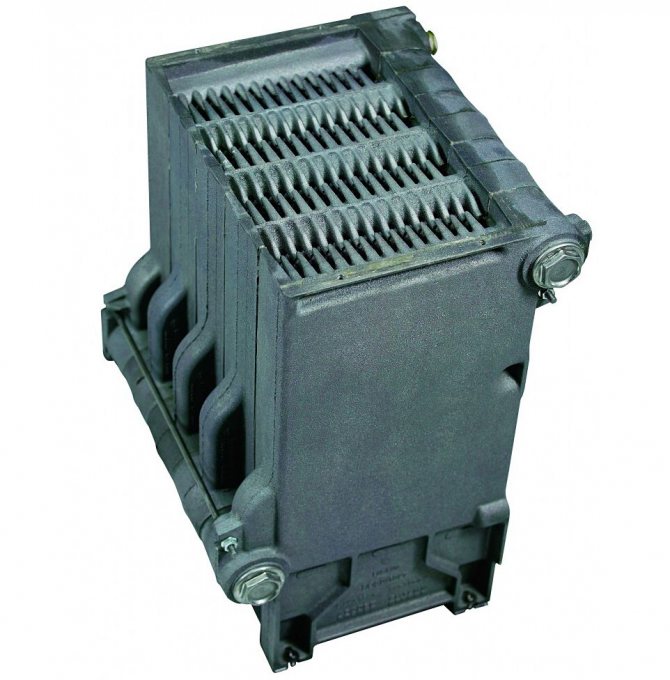

Virtually timeless, corrosion and scale resistant cast iron heat exchanger.
It was cast iron that was used to create the first coal and gas boilers. This is due to its anti-corrosion properties and a service life of 30 to 50 years. And in general, cast iron has little effect with any chemical substances. But as for the heat capacity, it is one of the highest. Therefore, even now, when many other types have appeared, cast iron heat exchangers continue to be in demand. They take longer to heat up, but they also retain heat for much longer after stopping heating.
Unfortunately, they have more disadvantages. Firstly, it is a huge weight and dimensions. Boilers with cast-iron heat exchangers take up a lot of space, and it is generally not possible to hang them on the wall. Only a floor-standing installation method, massive powerful boilers are demanding on the floor covering (their weight often exceeds 300-400 kg).
Secondly, they do not tolerate sudden changes in temperature. But in heating, the return line is always colder than the supply. Thirdly, in order to protect cast iron from these drops, they began to use special burners. And then the heat capacity has ceased to be an advantage. Therefore, in fact, the only advantage is the long service life.
Steel


To get rid of the disadvantages of cast iron, they began to use steel heat exchangers. They are lighter, the equipment takes up less space, and the price is much lower. In addition, steel heat exchangers are not so afraid of temperature changes, therefore they are very suitable as a heating element. And in the event of a breakdown, they can be repaired. Of course, not all models, but many.
Why, then, do cast iron heat exchangers continue to be used if steel has so many advantages? The fact is that not everything is so smooth. After all, steel is susceptible to corrosion, and this is already a huge disadvantage. Therefore, the service life is 2-3 times less, usually from 12 to 15 years. I would also like to draw your attention to the fact that steel can burn out. If you have already decided to choose a boiler with a heat exchanger made of this material, I advise you to find out in advance about the wall thickness. It should be 3 mm or more. Better than 5 mm.
Copper


The best metal in terms of heat transfer characteristics is copper. Perhaps there is only one drawback of copper heat exchangers. This is their high price, copper heat exchangers are usually installed on the model of the middle price segment and above (from 45-50 thousand rubles). But there are a lot of advantages:
- compact size;
- light weight;
- high efficiency;
- copper practically does not corrode;
- heats up and cools down quickly;
By the way, it is precisely because of the rapid heating that much less gas is spent, so savings can be considered another plus. As for the service life, manufacturers usually indicate 14-17 years, which corresponds to the realities. This is marginally more than steel, but still much less than cast iron. But for such a time, it will be possible to save much more on fuel.
Usually copper heat exchangers are installed in wall-hung boilers. Although found in the floor.
Aluminum
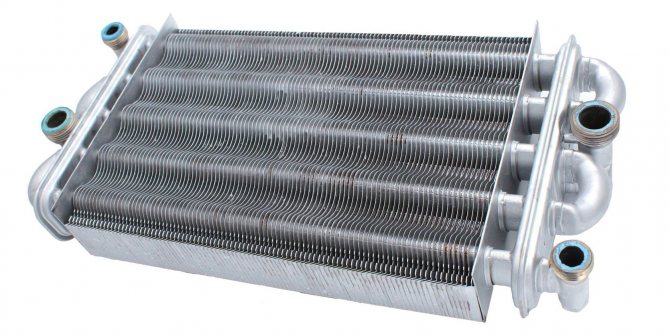

Aluminum is also used as a material for the heat exchanger of a gas boiler. It was first used in condensation models, but I will talk about them a little later. Aluminum heat exchangers are also installed in conventional convection boilers. It would seem, why are they needed if copper does its job well? It's all about the price. To reduce the cost of production, in copper heat exchangers they try to reduce the wall thickness. You don't need to do this with aluminum. It is already several times cheaper than copper, and the heat transfer properties are also quite high.
It turns out that an aluminum heat exchanger is thicker than a copper one. And this is its great advantage, because the service life is increased. Practice has shown that aluminum is even less susceptible to oxidation. But on the Internet, opinions differ on this matter. Therefore, it is difficult to say exactly which heat exchanger is better.
We recommend: wall-mounted models - with a copper or aluminum heat exchanger; floor - with cast iron. Of course, only steel is used in budget models.
Cast iron heat exchanger
The heat exchanger is made of cast iron, does not corrode, but requires careful maintenance and careful operation. These features result from their properties of cast iron and the main thing is the fragility of cast iron. Uneven heating, which most often occurs due to scale, leads to cracks in the heat exchanger.
Information: Flushing the coolant is an obligatory and basic element of the technical operation of a gas boiler. The coolant is being flushed
- Once a year, if used as a heat carrier - running water (not recommended),
- Once every 2 years, if used - antifreeze,
- Once every 4 years, if purified water is used.
Advantages of bithermic units
The advantages of heat exchangers with a single block extend both to the efficiency of heating as such and to the convenience of control, not to mention the higher reliability of the units. With regard to efficiency, bithermal radiators operate with a lower heat loss coefficient. If in a system divided into two blocks, heating of two blocks is required, then in this case the filling of one housing is serviced - accordingly, the volume of heat generated increases. In terms of control, a bithermal heat exchanger is more profitable for the same reason. Thermostats are guided by the performance of one solid block, which affects the accuracy of the data obtained. Reliability, in turn, is achieved by minimizing the connection infrastructure - in fact, only a connection is required between the heat exchanger and the supply channels.
Pros and cons
The main advantage of bithermic radiators has already been announced. They are cheaper and at the same time lose insignificantly in performance. The combination of the heating and DHW circuit has practically no effect on the heating rate of running water and at the same time does not reduce the amount of heated water. Comparing boilers of the same power from the same manufacturer, you can see that the permissible hot water consumption is practically the same.
The second aspect is the way the water is heated. Due to three or four chiseled fastening of the inner tube to the outer one, the contact area of the coolant with the heat exchanger increases. In fact, the heat from the plates is distributed not only over the surface of the outer tube, but also partially transfers to the inner tube.This increases the heating rate.
In the DHW circuit, during the use of only heating, the water heats up to the set heating temperature and does not take away heat, until the hot water tap is opened.
As soon as the hot water tap opens, there is already well-heated water in the pipes. The heating circuit is closed, and the rest of the water inside the heat exchanger gives off additional heat, without hindering its transition from the plates to the hot liquid in the inner cavity.
What about the cons?
And they are the same. The intricate surface shape inside the tubes potentially increases the rate of salt deposition. Especially if a high temperature for heating is set within the range of up to 95 ° C inclusive. However, this is to a greater extent not a problem of the heat exchanger, but of water treatment.
In heating, by definition, the coolant must be filled with a prepared one. To do this, the liquid is eliminated from excess salts, iron and other inclusions, or at least soften, antifreeze and other additives are added to prevent the formation of scale. Even if you do not prepare water, it moves in a closed loop in the heat supply system and over time salts leave from it, the total amount of which is not replenished.
With regard to hot water, everything depends on the adequacy of the user and the availability of pre-treatment and filtration. If there is a suspicion that the water is hard and contributes to the formation of scale, then a single-circuit boiler with a large channel section in the heat exchanger will be at risk.
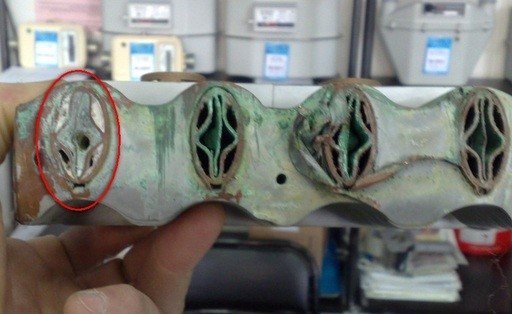

Scale in the heat exchanger
In any case, a filter or a filtering station should be installed before the boiler, excluding the ingress of salts and lime into the hot water supply and, of course, into the consumer's tap.
Another feature is the separate operation of the heating circuit and hot water supply:
- At the first moment, while hot water is open, with the heating operating, almost boiling water will flow (depending on the set heating parameters).
- The coolant does not warm up during the use of hot water, however, water heating, even with a very small volume, still has a high heat capacity and inertness. You will have to use hot water for a very long time to feel the decrease in heat in the room in winter.
But in the end, we can also say about the last advantage of the bithermal heat exchanger. In the summer, there are no problems with obtaining hot water. The source of heat for it is all the combustion of the fuel, and there is no need to warm up the entire circuit or even a specially prepared limited bypass circuit to please yourself with a hot shower.
Choice of coolant
For cast iron gas boilers, mainly such heat carriers are used as:
- distilled water;
- antifreeze.
According to its characteristics, cast iron cannot enter into any reaction with a liquid that does not freeze. The sections of the device are mounted so tightly that leaks are excluded even after antifreeze is introduced into the system.
The user, when choosing the medium that will circulate along the contour, should be guided by the following characteristics:
- by heating time - in this case, water has a lower density than antifreeze. Therefore, the water warms up faster. In time, the warm-up occurs from 15 to 40 minutes. It all depends on the quality of the coolant;
- but non-freezing gives off heat much longer, because in terms of its physical qualities it cools down more slowly than water.
Therefore, the coolant is selected on the basis of the principle for which the heating system will serve in the future, for permanent operation or for temporary heating of premises.
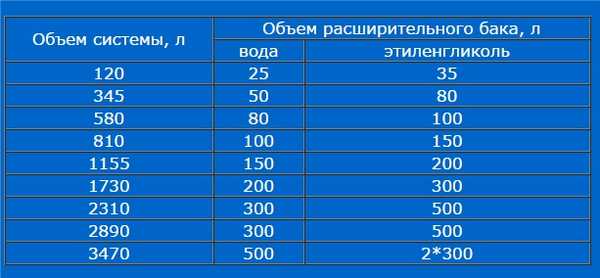

Design flaws
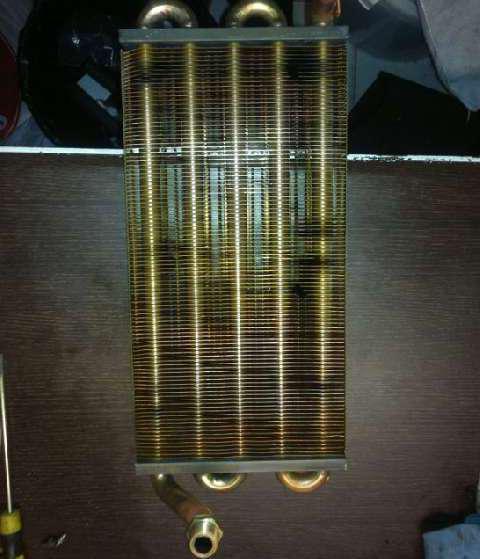

The main disadvantage of the bithermal design is the limitation when working with liquids saturated with salts.In this context, one can note the imperfection of the monoblock body and the coaxial circuits inside, which quickly become scaled up. In addition, a bithermal heat exchanger is not able to provide the same performance as with split radiators. This applies specifically to hot water supply, since the design itself assumes a smaller volume of water served for such tasks.
Structural device
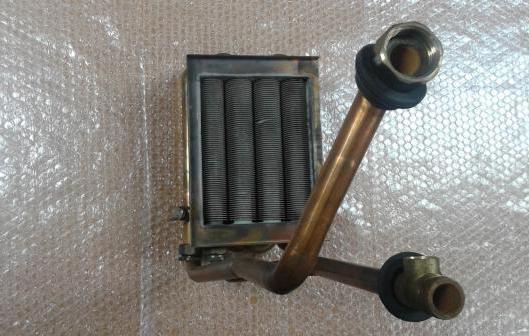

Now it is worth understanding the design features of bithermic radiators, which allow it to separately heat different media. Experts characterize such designs as "pipe in pipe" or "section in section". If in a conventional heat exchanger a set of pipes is assumed that have a hollow niche, then the bithermal device is distinguished by its internal division into several segments - these are zones in which water for hot water supply and heating circulates without mixing. And already according to the classical scheme, copper fins-plates are also attached to the pipes, increasing the heat transfer coefficient. Obviously, depending on the method of integration, other features of the radiator design will be provided for in the target equipment. In particular, the device of a bithermal heat exchanger of a gas boiler is oriented towards heating by a burner, therefore, the body can provide additional layers of protection. Mandatory for all heat exchangers, and means of ensuring safety against an electric current short circuit. Since the loops can be interfaced with other utility lines, grounding and the presence of fuses in the boiler stations are also mandatory.
How to properly mount the equipment
You can install such equipment both independently and with the help of boiler installation specialists. The only condition that cannot be violated is to include the boiler in the gas system itself, because such work will have to be entrusted to a specialist. Moreover, such people must have special approvals and certificates. If the homeowner violates this provision, then first of all, he will be disconnected from the system, and secondly, a very large monetary fine will be imposed. But in order to independently connect a cast-iron gas boiler, you still need construction skills.
Cast iron boilers have an impressive weight, so if a hinged boiler is bought, then an impressive frame must be mounted under it. It is necessary to install such equipment in a boiler room.
And there are special requirements for such a technical room:
- the ceiling height in the boiler room must be at least 3 meters, and the room must be at least 4 sq. meters. These parameters are suitable for a boiler with an average capacity, but the larger the boiler, the more it should be around the place. Usually such things are recommended by the manufacturer themselves;
- the presence of at least a single window, because there must be an air flow. The door opening must be 80 cm wide and the gap between the floor and the door leaf must be at least 35 mm;
- there must be a distance of at least 3.5 meters to electrical and gas installations or appliances;
- on the floor, in the place where the installation of the cast-iron boiler is planned, a cement screed is poured, and this place is reinforced with a steel plate. It is important to remember that the sheet of steel must be located under the entire surface of the bottom of the heating installation, and also protrude 3-4 cm outside on its front side;
- materials with refractory qualities, it is necessary to strengthen the entire part of the wall where the chimney pipe will pass.
You will be interested >> The principle of operation of a double-circuit gas boiler Ariston
The main paper for self-preparation of the boiler for mounting it into the system should be an accompanying document in the form of instructions developed by the manufacturer.
Such a document gives the parameters and regulates the procedure for how the boiler can be connected to the main pipeline, to the chimney system, as well as the return and supply system.
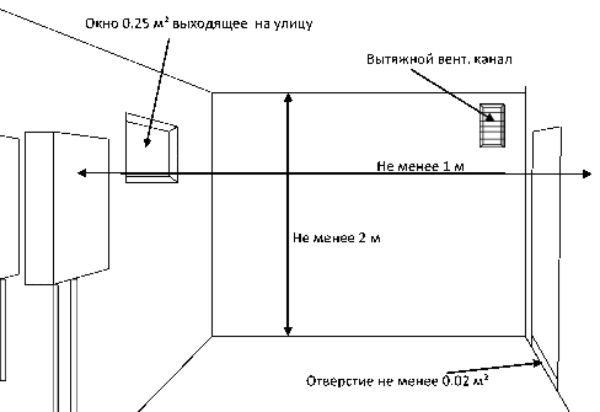

What does a bithermal heat exchanger look like?
The bithermal type of heating combines heat exchangers in its design, which are designed for heating, for flow-through DHW... The design of the device consists in connecting pipes of individual panels on a common platform of heat exchanger plates.
In the inner part of the pipe made of a metal heat conductor - copper, a second one is inserted, which is made in the shape of a diamond. In this case, the pipe in the inner part is connected to the outer in 3-4 places.
The space between them applies for heating water. The inner part is reserved for hot water supply. On the outer pipe, panels are fixed by pressing method to increase the area of heat exchange with waste, rapid heating of water.
How does it work
The radiator pipe is divided into 2 spaces, with the copper pipes being connected to each other in several places. There are the following bimetric heat exchangers - they have an inner pipe (DHW) made in the form of separate ovals, these devices are durable and reliable.
The advantages of radiators with a bithermal heat exchanger include a simple design. In radiators there is no need for a 3-way valve, secondary heat exchanger. Therefore, this type of heating is inexpensive.
For example, the fewer moving parts in the equipment, the less likely it is to break down. In many countries, gas radiators are equipped with a bithermal heat exchanger.
Operating conditions
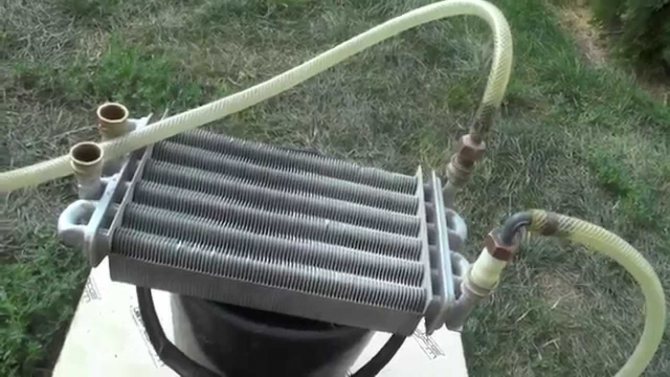

The bithermal heat exchanger needs to be flushed more often
It is worth purchasing a boiler with such a heat exchanger only if you are confident in a sufficiently good quality of water used as a heat carrier. It is imperative to install a system of filters and softeners, because the device has low maintainability. This simple step should not be neglected in order to minimize the likelihood of the need to go to the workshop. The documentation supplied with the boiler indicates the requirements for the heating medium. It is necessary to check that the water in the area corresponds to them.
If the exchanger fails, you must contact the service center. In practice, it sometimes turns out that repairmen take up work with such devices reluctantly and without guarantees, and as a result they have to buy a new one.
The structure is easily clogged with soot, limescale accumulates on it. This reduces the efficiency - one of its main advantages over separate options. It is advisable to periodically (every 2 years) clean the exchanger with a pressure pump. Before carrying out it, you need to consult the technical center regarding the composition of the solution and the technology of the procedure. Errors in this matter easily lead to depressurization; in such an incident, the heat exchanger needs to be replaced. It is good if there is an opportunity to invite a master to your home - this will allow you to get qualified advice without dismantling the boiler.
Aggressive cleaners are only used as a last resort if milder ones do not work.
Bithermal or split heat exchanger - which one to choose?
It is impossible to give an unambiguous answer to the question of which heat exchanger is better - bithermal or separate. With quality workmanship, the two options perform well on their own. The operating mode and the nuances that are associated with this and are visible to the consumer, or are not felt, or have a very similar nature. Those. both in the first case and in the second, it is necessary to get used to certain restrictions or features of the functioning of the heating unit.
A ready-made boiler with a bithermic heat exchanger will cost you less. In addition, without much complication of the design, only one heat exchange unit is used in the boiler, and it can be serviced even easier than the circuits separately.
In the case of a combined heat exchanger, it is easier to choose a high-quality boiler model. It may seem surprising, but even in the same line of boilers with separate devices, you can often find a combination of heat exchangers of different designs and materials for heating and hot water supply. When choosing a boiler, you will have to carefully check the nuances and technical characteristics of all its parts so that there are no mistakes.
It is impossible to argue that double-circuit heating units with separate heat exchangers are better due to their own suitability for repair. The scale issue can arise the same way for any boiler if untreated water is used. Repair for heat exchangers is always the same. If you take into account that a plate heat exchanger can be used in a separate version, you can generally notice that the combined one is much more tenacious.


